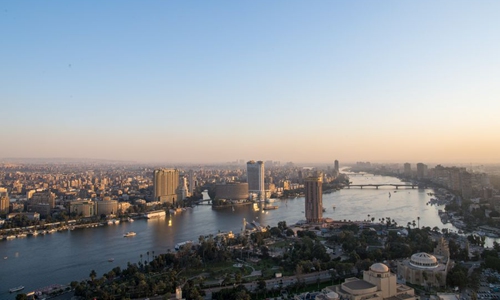
A view of the Nile River and the Cairo city is seen from the Cairo Tower in Cairo, Egypt, Nov. 24, 2019. (Xinhua/Wu Huiwo)
In an amusing atmosphere at a historical palace in the Sayeda Zeinab neighborhood of the Egyptian capital Cairo, a large audience of different ages interacted dynamically during an Aragoz show, the traditional Egyptian hand puppet performance.
Organized by the Wamda Troupe for Aragoz and Shadow Puppets in cooperation with Bibliotheca Alexandrina, the 3rd Egyptian Aragoz Festival ended on Wednesday night with a success.
The three-day event was meant to shed light on Aragoz as a unique art performance, give people a chance to see the beauty of puppet shows, and save the art that faces the danger of extinction.
In 2018, the United Nations Educational, Scientific, and Cultural Organization (UNESCO) registered the Aragoz as Egypt's Intangible Cultural Heritage in Need of Urgent Safeguarding.
Aragoz is a classic form of Egyptian theater art using traditional hand puppetry. During the performances, puppeteers remain hidden inside a small portable stage while an assistant interacts with the puppets and the crowd.
"After registering Aragoz as Egypt's Intangible Cultural Heritage in Need of Urgent Safeguarding by the UNESCO, urgent measures had to be taken to preserve the Egyptian art of Aragoz by organizing live performances for the mass. Then we and the Bibliotheca Alexandrina decided to organize this annual festival," Nabil Bahgat, head of the Wamda Troupe, told Xinhua.
He said that the festival was successful in terms of attracting more people to the fascinating shows.
"The audiences were enjoying our shows. Many of them only saw Aragoz on TV and in movies, while those who saw live Aragoz performances recalled childhood memories," said Bahgat, who is also a professor of theater at Helwan University.
"We are now in the era of technology and direct communication has become limited, so I see that we have an opportunity to spread this art again because virtual social media could not compensate for the human need to watch such live shows," he stressed.
Bahgat noted that people must keep pace with science and modernization, but without alienating human and artistic heritages.
"We even seek to spread this art outside Egypt, and we have succeeded in this through participating in festivals and artistic events in more than 30 countries," he said.
Aragoz takes its name from the main puppet, whose distinctive voice is created with a voice modifier. Performers and the audience interact throughout the show, which creates a comic and entertaining atmosphere, and practitioners must be skilled in manipulating the puppets.
The art used to be presented by traveling performers, who moved from one folk celebration to another. However, when these performances began to dwindle, performers and their assistants settled permanently in fixed places. The number of surviving practitioners has diminished, while many of those who once-performed stories have now disappeared.
Many people see the need of preserving the Aragoz shows, citing that it's not only an important traditional cultural heritage in the country, but also serves to entertain the public, especially the children.
Xinhua




